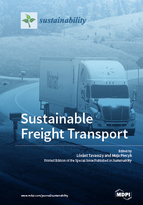Sustainable Freight Transport
A special issue of Sustainability (ISSN 2071-1050). This special issue belongs to the section "Sustainable Transportation".
Deadline for manuscript submissions: closed (30 June 2018) | Viewed by 78963
Special Issue Editors
Interests: freight transport systems; city logistics; global logistic networks
Special Issue Information
Dear Colleagues,
We are calling for papers for a Special Issue of the journal Sustainability on research into collective interventions to radically reduce greenhouse gas (GHG) emissions from freight transport, in line with the political targets of COP21 to COP23. In order to meet these targets, by 2050, freight transport should have reduced its GHG emissions by 80–85%. This reduction represents a significant challenge with multiple technical, operational, and political aspects. Designing, testing, and implementation of effective interventions (managerial or technical) and appropriate policy measures need multi-disciplinary, multi-country research. Policy oriented papers may focus on the operationalization and evaluation of interventions, across a wider range of alternatives, and set within the larger system of stakeholders surrounding freight transport. Promising options are not limited to introducing new transport technologies, but can also include changes in framework conditions for transport, in terms of production and logistics processes. One can note that the prediction of impacts of new policies is far from trivial due to the inherent complexity of the system. Amongst other areas, this complexity resides in the interfaces between freight transportation, logistics and supply chain management. We welcome contributions discussing these relations. Thus far, much research has focused on long term policies such as modal shift in freight transport. The complications of these policies are now slowly being recognized. Predicted effects of pre-designed policies may not materialize due to various implementation issues, behavioral non-response or rebound mechanisms. Relatively new approaches from a sense-and-respond framing, such as standardized measurement and allocation, science-based targets and innovative carbon market designs may be a better way to help to steer the system towards achieving targets. Ultimately, proposed papers for this Special Issue may cover a broad range of private strategies and public interventions, as long as the focus is on GHG reduction. Papers should concern specific reduction measures or approaches to support these, including a clear discussion of the expected impact on global GHG emissions.
Prof. Dr. L.A. TavasszyDr. M. Piecyk
Guest Editors
Manuscript Submission Information
Manuscripts should be submitted online at www.mdpi.com by registering and logging in to this website. Once you are registered, click here to go to the submission form. Manuscripts can be submitted until the deadline. All submissions that pass pre-check are peer-reviewed. Accepted papers will be published continuously in the journal (as soon as accepted) and will be listed together on the special issue website. Research articles, review articles as well as short communications are invited. For planned papers, a title and short abstract (about 100 words) can be sent to the Editorial Office for announcement on this website.
Submitted manuscripts should not have been published previously, nor be under consideration for publication elsewhere (except conference proceedings papers). All manuscripts are thoroughly refereed through a single-blind peer-review process. A guide for authors and other relevant information for submission of manuscripts is available on the Instructions for Authors page. Sustainability is an international peer-reviewed open access semimonthly journal published by MDPI.
Please visit the Instructions for Authors page before submitting a manuscript. The Article Processing Charge (APC) for publication in this open access journal is 2400 CHF (Swiss Francs). Submitted papers should be well formatted and use good English. Authors may use MDPI's English editing service prior to publication or during author revisions.
Keywords
- Freight transportation
- Logistics
- Supply chain management
- Greenhouse gases
- Carbon reduction
- Climate change






